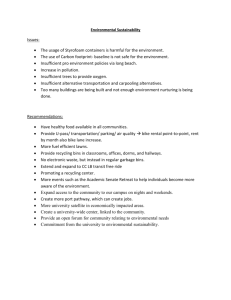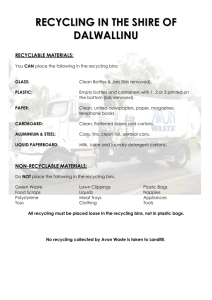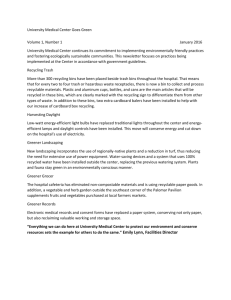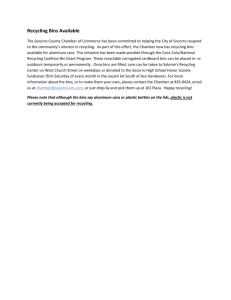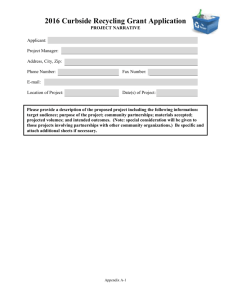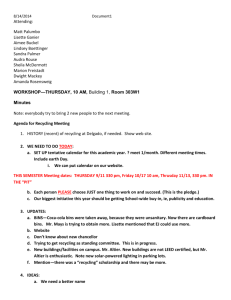All About Books - Faculty Homepages
advertisement
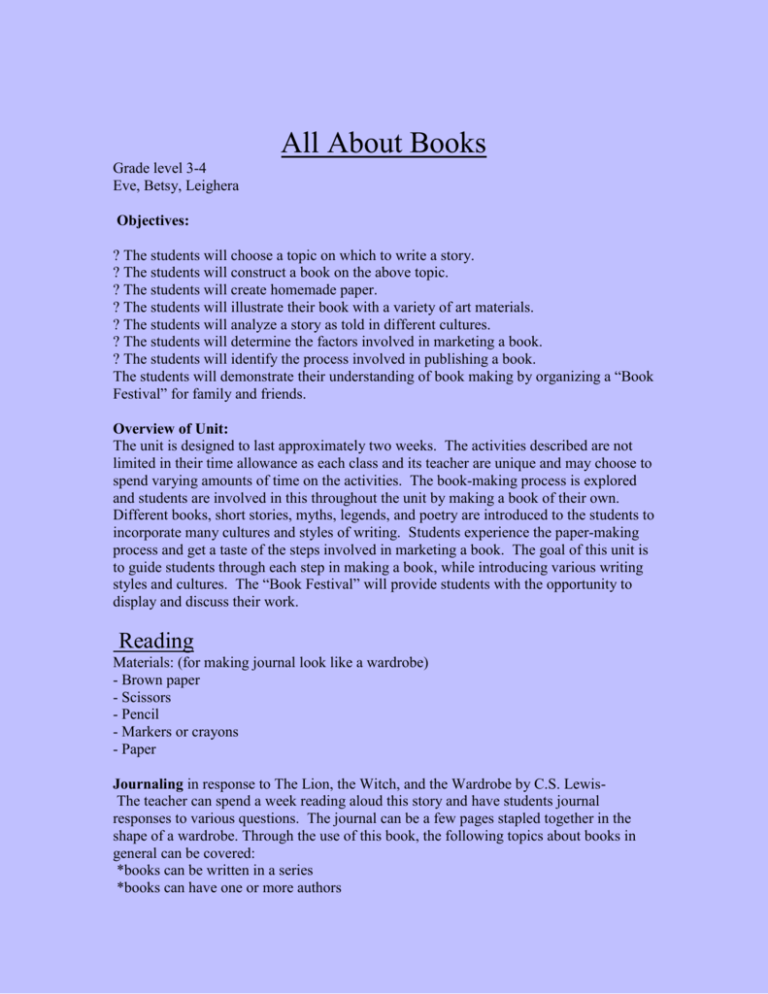
All About Books Grade level 3-4 Eve, Betsy, Leighera Objectives: ? The students will choose a topic on which to write a story. ? The students will construct a book on the above topic. ? The students will create homemade paper. ? The students will illustrate their book with a variety of art materials. ? The students will analyze a story as told in different cultures. ? The students will determine the factors involved in marketing a book. ? The students will identify the process involved in publishing a book. The students will demonstrate their understanding of book making by organizing a “Book Festival” for family and friends. Overview of Unit: The unit is designed to last approximately two weeks. The activities described are not limited in their time allowance as each class and its teacher are unique and may choose to spend varying amounts of time on the activities. The book-making process is explored and students are involved in this throughout the unit by making a book of their own. Different books, short stories, myths, legends, and poetry are introduced to the students to incorporate many cultures and styles of writing. Students experience the paper-making process and get a taste of the steps involved in marketing a book. The goal of this unit is to guide students through each step in making a book, while introducing various writing styles and cultures. The “Book Festival” will provide students with the opportunity to display and discuss their work. Reading Materials: (for making journal look like a wardrobe) - Brown paper - Scissors - Pencil - Markers or crayons - Paper Journaling in response to The Lion, the Witch, and the Wardrobe by C.S. LewisThe teacher can spend a week reading aloud this story and have students journal responses to various questions. The journal can be a few pages stapled together in the shape of a wardrobe. Through the use of this book, the following topics about books in general can be covered: *books can be written in a series *books can have one or more authors *all books have titles, authors, publishers *character, plot, setting, theme *book dedications and covers Students can begin to brainstorm ideas for their end-of-the-unit project which is making a book (As an option for students with special needs, provide tape recorders to them to get their thoughts out or have a buddy help with writing.) Vocabulary FocusNumerous words can be pulled out of the book as new vocabulary words. The teacher can use his/her discretion to decide which words may confuse students and that are important to the meaning of the story. Other words that may work well as vocabulary words involve the make-up of a book. Here are a few examples: theme, publisher, copyright, author, illustrator, dedication, characters, setting, chapter, title, series, table of contents. The new words discovered may be posted on a board at the front of the room so students can remember them. This will be helpful for students that are ESL or those that struggle with language. Writing ProcessIntroduce drafting, brainstorming, outlines, and final copy. Help students continue brainstorming and start on an outline. Science Materials: - Paper making (buy a basic paper making kit) - Recycled newspapers and computer paper -ask the students to bring some in - You can add flowers, lint, glitter, fragrance or any thing to make a texture or smell - Blender or two - Water - Big bucket or bin to pore the pulp into - Old towels to blot up extra water - Something to hang the wet paper on Paper-makingBring books or video materials into classroom that discuss the paper-making process. Include that the process starts with tress, cutting them down, making a pulp, bleaching, drying, and packaging. Students will gather materials from home that can be used to make their own paper. The focus is on the process and incorporating recycling old to make something new and useable. All students will make at least one sheet of paper that will be used as the cover for their own book. Recycling- Items to decorate a poster to go above a recycle bin: - Paint - Poster Paper - Glue - Glitter - Markers - Crayons - Any items you would like to use If recycling bins are located around the school, students can decorate posters to attach to the bins describing the use of the bin (the type of recyclable material.) If recycling bins are not present in the school, plans can be made to bring them in. The recycling bins can immediately begin to be used by the students. They can collect aluminum cans from home to place in the bins. When the bins are full, they can be taken to a recycling center. Tree-plantingWith the money earned through recycling, the students can purchase one or more trees to plant either on school property or in another community area. Social studies Materials: -variety of authors and styles of writing (Greek myths, haiku, fairy tales, Native American legends, Russian fables) -poster board -tacks -world map, markers Authors From Around the World – The teacher can present students with a variety of authors and styles of writing (short stories, poems, haiku, myths.) The author and his/her book being looked at can be placed in an “Author’s Corner” so students can look through the book on their own. It would be helpful to have a map provided so students can find the location of the story/poem, etc. or mark the area the author is from. Decoding and Sight wordsWhile the teacher is reading various writings to the students, he/she can ask students to pick out words they have not seen before. The students can write these words on a “Word Wall” bulletin board or poster board. Story-telling Throughout CulturesA teacher may choose a story/fairy tale that has multiple versions in different cultures, for example Cinderella has multiple versions in Western European cultures as well as in the Chinese culture. As the teacher reads these to the students, differences can be pointed out. Why would the same fairy tale have different versions? Possible answers to this can be suggested by students. To compare two versions of the story, students can illustrate their favorite scene but have two pictures-one showing one version and the other demonstrating the scene in another version of the story. Math Materials: -play money -visitor -paper and pencil to divide out money and brainstorm Book marketingInvite a local person from a publishing company to visit the classroom. This person can discuss the process of book marketing involving the distribution of profit, expenses, and the people involved in putting a book together. To practice what they have learned about this process, students will break into groups. Each person in the group will represent a person involved in the book-making process (author, illustrator, publisher, etc.) The teacher will provide the groups with numbers to correlate with expenses and the amount of money each person in the process may take home for a profit. The students will use problem solving skills to determine at which price they will market their book. A few examples can be given to each group and solved through the use of play money. As part of each student’s final steps in making his/her own book, the class will be responsible for giving their book a “market” price and explaining why they labeled it as they did. Art/Drama/Music Materials: -backdrops -simple props and costumes -any art materials students choose to use in designing their cover-page and illustrating their book ArtAfter students have the rough draft of their story written, they can begin to incorporate pictures and drawings. The last step in the book-writing process is the designing of the cover-the student as an illustrator. The cover page is designed from the paper each student makes in class. Melodramas (help build student fluency)The focus of the activity is to involve the whole class in acting out passages from various fairy tales. The teacher may ask for volunteers to stand in as key characters. The rest of the class acts as an interactive audience by adding in background effects such as gasping, weather noises, laughter, crowd noises, cheering, etc. The teacher can give the volunteer students a few simple lines that the rest of the class can help them remember. These students will also have a chance to practice them before going “on-stage.” The passages that are chosen are ones in which most, if not all, students have heard them before. Here are a few examples of fairy or folk tales to choose from: The Three Little Pigs Goldilocks and the Three Little Bears Rumpelstiltskin Humpty-Dumpty Snow White and the Seven Dwarfs Physical Education Book/author tag (modeled after TV tag)Bring students outside or into the gym to play tag. There can be a few students that are “it.” Instead of yelling out a TV show to keep from getting tagged, a student has to yell out a book title, fairy tale, short story, or any author of these. Examples will be given for students to choose from throughout this unit. Book Festival The culminating activity of this unit is a book festival. The students’ parents/guardians, relatives, or faculty members are invited to the classroom to view student work on display. Refreshments are provided for the authors/illustrators/ publishers to demonstrate their work and give them an opportunity to sell it for a reasonable price if they choose. Bibliography Bullinan, Bernice E., Galda, Lee. (1998). Literature and the child. Harcourt and Brace, Co. Lewis, C.S. The lion, the witch, and the wardrobe. (other possible books/stories that can be used throughout this unit-taken from Lit) BOOKS ABOUT WRITERS: Carle, Eric. The art of Eric Carle. Cleary, Beverly. A girl from Yamhill. BOOKS ABOUT WRITING: Asher, Sandy. Where do you get your ideas? Greenfield, Howard. Books: From writer to reader. BOOKS THAT CELEBRATE SIMILARITIES AND DIFFERENCES: Adoff, Arnold. All the colors of the race. Lankford, Mary D. Hopscotch around the world. INTERNATIONAL CHILDREN’S BOOKS: Joseph, Lynn. Coconut kind of day: Island poems. Wells, Ruth. A to Zen: A book of Japanese culture.


